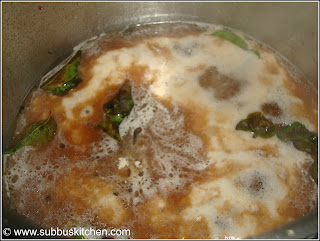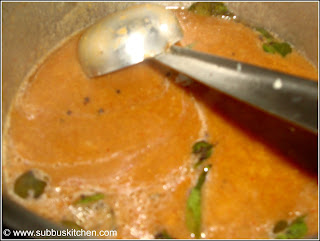Sambar Vadai, a scrumptious snack, its extremely appetizing, tastes so good... we cannot stop with taking one. Sambar Vadai is not so difficult recipe to make, but there are small tips and tricks that i am going to explain here will make your Sambar vadai very special.
The Sambar is a key part of this recipe and I have given here a perfect recipe for the Sambar which I believe being followed in the Chennai hotels.
| Servings | 15 pcs. |
| Preparation Time | 3 hours |
| Cooking Time | 1.5 hours |
Ingredients for Making Vadai:
| Urdhal | 1 Cup |
| Corainder Leaves | 1 teaspoon finely chopped |
| Curry leaves | 1 teaspoon finely chopped |
| Salt | to taste (I have used 1 teaspoon) |
| Oil | For Frying |
Ingredients for making Sambar:
| Tamarind | 1 Lemon Size |
| Corainder Leaves | 1 teaspoon finely chopped |
| Thur Dal | 1/2 Cup |
| Salt | to taste |
| Pumpkin | 1 cup(Finely Chopped) |
| Grated Jaggery | 2 teaspoon(Finely Chopped) |
Ingredients for Grinding (for Sambar):
| Channa dal(Gram dal) | 1 tablespoon |
| Coriander Seeds | 1 tablespoon |
| Cumin seeds | 1/2 teaspoon |
| Red chilli | 8 |
| Fenugeek seeds | 1/4 teaspoon |
Ingredients for Seasoning (for Sambar):
| Mustard Seeds | 1 teaspoon |
| Curry Leaves | Few |
| Hing | 1/2 teaspoon |
| Oil | 1 teaspoon |
| Ghee | 1 teaspoon |
| Corainder Leaves | 1 teaspoon Finely Chopped |
| Onion | 1 |
Method - for making Sambar:
- Soak the tamarind in water for 10 minutes and extract the tamarind juice and keep it aside
- Cook the thurdal and finely chopped pumpkin in a pressure cooker. Pumpkin is a key ingredient here which will give a light sweet taste to sambar and also the thickness.
- Heat a pan, add the grinding ingredients and dry fry them till the dals turn golden brown
- Take all the fried ingredients in a mixer
- Grind all the ingredients to a fine powder and take this in a bowl. This is the Sambar Powder that we are going to add with the Sambar after few steps.
- Heat a pan, add oil and when the oil is hot, add mustard seeds. When the mustard seeds starts to sputter, add chopped curry leaves and hing.
- Add the tamarind extract and salt and allow the mixture to boil till the raw smell of the tamarind goes off.
- Now add little water with the Sambar Powder (which we prepared few steps before) and mix well. We can also add water while grinding and make it a paste. The main reason for adding water is that, when the sambar powder is added to tamarind extract it should not form lumps. So, if we make the sambar powder as a paste then it mixes well with the tamarind extract. When the raw smell of the tamarind extract goes off, add the sambar powder paste and immediately stir with a ladle to mix well
- Now take the cooked dal and pumpkin and smash it nicely with the help of back of a ladle. This should be like a paste. It is very important to make sure that the dal is cooked properly and it should get smashed when we press it with the ladle.

- Add the smashed dal and pumpkin to the sambar and stir well. Keep the flame in medium low and wait for the sambar to start boiling. When the sambar starts to boil, add grated jaggery and remove from flame and garnish with coriander leaves
- Now the sambar is ready.
Method for making Vada:
- Soak the urdal in water for 3 hours. We can make medu vada just by soaking the vadas in water for 45 minutes but if we soak it for more hours then we would get more softer vadas
- After 45 minutes, drain the water and add the urdal to the mixer/grinder
- Grind the urdal first without adding water. We can sprinkle very little water to grind it to a nice paste

- We should not add more water, the ground urdal batter should roll like a ball so we should only sprinkle water just to move the blade of the mixer/grinder
- When the urdal batter is ground, we can test the batter by dropping a small piece of batter in a bowl of water. If the batter is not ground properly, then it will immediately sink in water
- If the batter is ground completely, then the batter will immediately start floating on the water. This is the right consistency

- Now take the urdal batter in a bowl and add salt and mix well. Aeration is very important to make the vada crisp and fluffy. The Aeration is natural if the dough is being prepared in a conventional way in the manual grinder (Aaatum Kal). Grinder is also equally good. But if you are making the dough in Mixer, the make sure that you mix the dough well using your hands for about 2-3 minutes continiously to get the aeration. This will help to get more softer crispy vadai.
- Now heat oil in a pan, and when the oil is hot, we can test it by dropping a little drop of batter and if it raises immediately in oil, then we are ready to drop vadas
- We can wet our hands and take a small quantity of urdal batter and roll it to a ball and make a small hole in the center and gently drop in the oil
- Repeat the above step for 4 - 5 vadas
- When the vadas are fried enough in one side, use the spatula to turn it to other side
- Allow the vadas to fry in oil in a medium flame and when bubbles ceases, we can take the vadas out of the oil
Method to make Sambar Vada:
- As we are already ready with the sambar, we have to take 2 ladles of sambar in a bowl. Add 2 cups of boilig water and make mix well. Also add salt (1/2 tea spoon or less) and stir well.
- Keep this mixture ready to soak the fried vadas
- When we take the fried vadas from oil, we have to immediately soak it in the above explained sambar-hot water mixture and allow them to soak till we fry the next set of vadas (for about 3-4 mins)

- Remove the soaked sambar vadas in a separate plate or a broad vessel
- Repeat the above step till all the fried vadas are soaked and taken in the vessel
- While serving, take the soaked vada in a bowl and on top of it, add the hot sambar and one teaspoon of Ghee.
- Garnish it with chopped coriander leaves and finely chopped onions and serve hot
- We need to soak urdal atleast for 3 hours. Soaking for 8 hours will make more smooth vadas
- Generally we are cautious that the vada should not consume more oil so we prepare the batter and prepare the vadas immediately. But for this Dhahi vada, we can keep the ground batter aside for ateast 10 minutes so that the vadas come fluffy and soft.
- Aeration is very important to make the vada crisp and fluffy. The Aeration is natural if the dough is being prepared in a conventional way in the manual grinder (Aaatum Kal). Grinder is also equally good. But if you are making the dough in Mixer, the make sure that you mix the dough well using your hands for about 2-3 minutes to get the aeration.
- We need to make the size of the vada smaller than we do for usual vada as we are going to dip in diluted sambar-hot water mixture and because of which the vada tend to become fluffy
- Here i have used pumpkin as sambar vegetable. There are 2 reasons behind this
- Pumpkin when cooked and smshed with thur dal increases the quantity of the sambar
- Pumpkin gives a slight sweeter taste and great flavour for sambar
- Jaggery that i have added in the last step of the sambar is optional. The jaggery sweetness will give a nice flavour to sambar. If you dont like the little sweetness you can avoid using the jaggery
- Instead of pumpkin, we can also use sambar onions(baby onions) which will also be tastier, in that case, while grinding the sambar powder, we can 4-5 baby onions and grind it that will enhance the taste
- The water we add to the sambar should be strictlty the hot water. If we add cold water then the sambar will become bad quickly
- Unlike dhahi vada(Thayir Vadai), we cannot make the vadas before 1 day and keep it in refrigerator, we can prepare the vadas 2 hour before and soak it in sambar-hot water mixture and take them in a broad plate. While serving, we have heat the sambar and take the dipped vada in a bowl and top up with the hot sambar and garnish with coriander leaves/onion and serve hot
- This way we can plan for a wonderful starter for our guests










